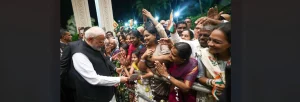(April 23, 2025) Revolutions aren’t always loud. Sometimes, they arrive as a poem, a performance, or a presence that lingers. As the Indian Council for Cultural Relations (ICCR) turns 75 in 2025, this post-independence idea stands as India’s most powerful cultural bridge to the world, a soft power emissary shaping global perceptions through connection.
As the cultural arm of the Ministry of External Affairs of India, ICCR represents India not through politics or commerce, but through art, education, and human engagement. It was founded with the aim to establish, revive, and strengthen cultural relations and mutual understanding between India and other countries, and to promote cultural exchange with the rest of the world. From humble beginnings to global influence, over its seven-and-a-half-decade journey, it has helped script India’s presence in hearts and minds across continents.

Photo Credit: ICCR
A vision born in the wake of freedom
When India gained independence in 1947, reclaiming its voice on the global stage became imperative. In April 1950, Maulana Abul Kalam Azad, India’s first Education Minister and a scholar-statesman, founded the ICCR with a mission to present India as seen through Indian eyes.
Azad believed that India’s civilisational identity, its pluralism, philosophy, and creative vitality was as crucial to its global presence as its economic or military power. “True diplomacy,” he argued, “must engage with people, not just policies.” Jawaharlal Nehru echoed this vision, expanding ICCR’s scope beyond Asia to the world, believing India had something profound to share, and that was not just yoga or temples, but the lived experience of tolerance, synthesis, and spiritual depth.

Maulana Azad addressing ICCR meeting in 1950 | Photo Credit: Government of India archives
Reconnecting with a dispersed heritage
In the 1960s, as Caribbean nations like Guyana, and Trinidad & Tobago, and later in 1970s as Suriname gained independence, ICCR identified a powerful opportunity of reconnecting with the descendants of indentured Indian labourers who had been taken there during colonial times. These communities, far from their ancestral roots, still held on to fragments of Indian language, music, and ritual.
ICCR responded not by dispatching bureaucrats, but lecturers who were teachers of Hindi, Bhojpuri, Sanskrit, music, and dance. These were ambassadors who stepped into community halls, temples, and living rooms, not as officials, but as family. They taught more than grammar; they revived lost lullabies and ancestral prayers, and helped the diaspora rediscover a heritage they had yearned for.
To deepen these bonds, ICCR offered scholarships to young Caribbean Indians to study in Indian universities. These students returned as cultural bridges, igniting local art movements, radio programming in Indian languages, and festivals that continue to this day. The Caribbean model became a blueprint for diaspora outreach globally.
Over the decades, ICCR has expanded its diaspora outreach through structured programs supporting hundreds of cultural delegations not only to diaspora-rich regions of the past like Fiji, Mauritius, Malaysia, and South Africa, but to nearly every corner of the globe. It has helped establish Indian cultural associations worldwide and provided long-term support for regional festivals, language courses, and community-led initiatives.

Ramlila by Bharatiya Kala Kendra Troupe supported by ICCR during a 1979 trip to Hong Kong, Taiwan, Philippines, Thailand and Vietnam
By the 1990s, its collaborations had already reached second- and third-generation Indian communities through workshops, and folk arts revival programs. In the years since, as the Indian diaspora has grown to become one of the most widespread in the world, ICCR too has extended its footprint, reaching both younger audiences and elders, and helping keep Indian tradition alive across continents and generations.
Strategic soft power, rooted in culture
ICCR’s strength lies in blending culture with diplomacy. Since 1970, it has functioned under the Ministry of External Affairs, embedding its work firmly within India’s foreign policy. This synergy ensures that cultural diplomacy isn’t an afterthought, it’s a frontline strategy.
From sending a Bharatanatyam troupe to post-conflict Iraq to gifting a bronze Gandhi statue to South Africa, ICCR’s gestures are more than symbolic. They’re expressions of shared values and carefully curated acts of goodwill.
Today, ICCR operates 38 cultural centres in cities like Berlin, Colombo, Paramaribo, and Johannesburg, each acting as a creative embassy where Indian culture can be experienced, not just observed. These centres host everything from Hindi classes to yoga workshops, Kathak recitals to film screenings, and even cooking classes in regional Indian cuisines.
Scholarships that shape futures and nations
ICCR’s most transformative legacy is its scholarship program. Every year, over 4,000 students from nearly 190 countries come to India under ICCR’s sponsorship. At any given time, more than 8,000 foreign students are immersed in India’s education system, exploring its languages, philosophies, sciences, and arts.
Some of these students go on to become powerful changemakers. Dr. Ram Baran Yadav, former President of Nepal, studied medicine in Kolkata and Chandigarh. “My education in India gave me more than a degree. It gave me perspective and lasting friendships,” he says.
Dr. Harini Amarasuriya, now the Prime Minister of Sri Lanka, recalls the life changing experience of studying in India on the ICCR scholarship. “My three years at Delhi University were transformative. It was the first time I lived away from home. That experience shaped my worldview.”
Such testimonies reveal the deep, often unspoken, impact of India’s cultural diplomacy. These students return not only as alumni but as lifelong advocates of India’s soft power.
A dialogue through art
ICCR’s cultural exchange program is among the largest in the world. Every year, nearly 800 Indian artists perform abroad under its aegis, while more than 1,000 foreign performers are hosted in India.
Festivals curated by ICCR like the Indo-Latin American Cultural Festival, the Ramayana Mela in Southeast Asia, or the Vasudhaiva Kutumbakam conference are events that transcend borders. In these spaces, a Chilean guitarist might collaborate with a Hindustani vocalist, or a Kenyan dancer might perform alongside a Manipuri troupe.
Yoga, once a niche Indian practice, has become a global wellness movement with ICCR at its forefront. The Council coordinates International Day of Yoga events in over 100 countries, turning plazas, parks, and waterfronts into open-air yoga studios. Sanskrit chants in New York’s Central Park or pranayama sessions in Lagos are now familiar scenes.
Centres of thought, not just performance
Beyond performance arts, ICCR also nurtures India’s intellectual legacy. Through 53 academic Chairs in 33 countries, it supports teaching and research in areas like Sanskrit, Indian philosophy, Gandhian thought, Ayurveda, and classical literature.
At universities in Hungary, Mongolia, Peru, and South Africa, Indian Chairs have developed full-fledged departments and influenced academic curricula. In some cases, these scholars have revived interest in ancient texts, built libraries of Indian knowledge, or published joint research that bridges Eastern and Western paradigms.
ICCR: A true Global Indian institution
While the term ‘Global Indian’ is often reserved for individuals who achieve success abroad, ICCR as an institution embodies this spirit at scale. It is, in essence, a Global Indian emissary building cross-cultural friendships, enabling migration of ideas, and expanding India’s presence in foreign societies through its initiatives.
ICCR has acted as a lighthouse for diaspora communities, a mentor for future leaders, and a curator of civilisational diplomacy. Its cultural centres and academic chairs function as long-term, soft power investments, planting seeds that bloom across generations.
View this post on Instagram
A quiet revolution that endures
As ICCR completes 75 years, it stands as proof that in a world increasingly fractured by difference, it is art, empathy, and storytelling that can still unite us.
From Diwali in Durban to Holi in The Hague, nearly every Indian festival today is celebrated in collaboration with diaspora communities around the world, often with ICCR’s support, turning cultural memory into shared public celebration.
When a Colombian child learns Hindi in Bogotá, when an Indonesian singer performs Mirabai bhajans, or when a Tanzanian scholar delivers a lecture on Rabindranath Tagore, ICCR’s vision becomes real. It reminds us that diplomacy isn’t always loud. Sometimes, it’s a whispered Sanskrit verse. A tabla beat echoing across continents. A quiet revolution, still unfolding.
ALSO READ: Ramayana’s global odyssey: Cultural adaptations and twists




